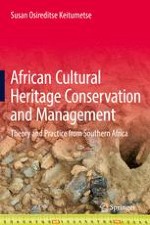2016 | OriginalPaper | Buchkapitel
4. Towards Sustainable Communities: Community-Based Cultural Heritage Resources Management (COBACHREM) Model
verfasst von : Susan Osireditse Keitumetse
Erschienen in: African Cultural Heritage Conservation and Management
Aktivieren Sie unsere intelligente Suche, um passende Fachinhalte oder Patente zu finden.
Wählen Sie Textabschnitte aus um mit Künstlicher Intelligenz passenden Patente zu finden. powered by
Markieren Sie Textabschnitte, um KI-gestützt weitere passende Inhalte zu finden. powered by
